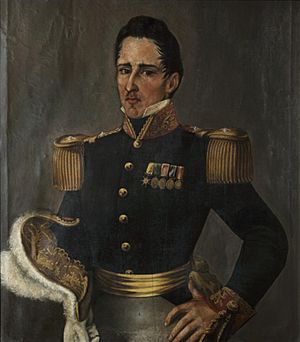José María Córdova facts for kids
Quick facts for kids
José María Córdova
|
|
|---|---|
 |
|
| Nickname(s) | "Hero of Ayacucho" "the one with the terrible look" |
| Born | September 8, 1799 Concepción, Antioquia Viceroyalty of New Granada, Spanish Empire |
| Died | October 17, 1829 Santuario, Antioquia Gran Colombia |
| Allegiance | United Provinces of New Granada(until 1819) Gran Colombia |
| Years of service | 1814-1829 |
| Rank | General |
| Battles/wars | Colombian Independence War
|
José María Córdova Muñoz was a brave General in the Colombian army. He is often called the "Hero of Ayacucho". He played a big part in helping Colombia, Perú, and Bolivia become free from Spanish rule during the Independence Wars.
José María Córdova was born in Concepción, Antioquia, on September 8, 1799. He passed away in Santuario, Antioquia, on October 17, 1829.
Contents
Starting a Military Career
Córdova began his military journey in 1814. He joined the new Engineer Corps in the Antioquia province. This group was just started by Francisco José de Caldas in Medellín.
Córdova was very interested in the military. He also strongly believed in the idea of a revolution. This was because Colombia had declared its independence. Antioquia also declared itself free, calling itself the "Republic of Antioquia."
Early Battles and Promotions
In 1815, Córdova joined the revolutionary army. He was sent to Tunja. There, he became a second lieutenant. He fought under a French Colonel named Emanuel Roergas Serviez. Serviez became a very important teacher and guide for Córdova.
Córdova's group helped win the battle of “Río Palo”. Because of his bravery, Córdova became a Lieutenant. He was only 16 years old at the time.
Facing Spanish Forces
The Spanish troops started to fight back in 1815. This was known as the Spanish reconquest. Colonel Serviez became the main commander of the army. Córdova continued to serve under him.
In 1816, Serviez's forces, including Córdova's group, were defeated. They had to go back to the Llanos Orientales. After some time, Córdova was given a command position. This happened before Simón Bolívar arrived in Venezuela in 1816.
Córdova was then sent to the Guayana Region in 1817. Later, Bolívar added him to his main group of senior officers.
Leading the Fight for Freedom
In 1819, soon after the important Battle of Boyacá, General Bolívar promoted Córdova. He became a General. Bolívar gave him a special job: to remove all Spanish forces from the province of Antioquia.
The Spanish army had been badly beaten at Boyacá. Córdova's task was to stop the Spanish from gathering their forces again in northern Colombia. He started his mission with 190 soldiers. He arrived in Rionegro on August 25 and in Medellín on August 30.
Victory in Antioquia
Once in Antioquia, Córdova became the Military Chief. Another leader, José Manuel Restrepo, was in charge of public administration. Córdova quickly put together a small army of 700 volunteers.
On February 12, 1820, Córdova's army defeated the Spanish army. This happened at the “Battle of Chorros Blancos” in Yarumal, Antioquia. This victory was very important. It meant that Spanish troops were no longer present in Antioquia.
Campaigns in Ecuador and Peru
After finishing his mission in Antioquia, Córdova joined the battle for Cartagena in 1821. He led his own Antioquia Battalion. After that, Bolívar ordered Córdova to join the Southern Campaign. He went to Ecuador. There, he fought bravely in the Battle of Pichincha in 1822.
In 1824, Córdova was already a Brigadier General. He was sent to Peru to join General Antonio José de Sucre. Their goal was to defeat the Spanish forces there. In the famous Battle of Ayacucho, Córdova led the first division of the army.
Thanks to his amazing service, he earned the nickname "The Lion of Ayacucho." This victory made Peru truly independent. It also led to other countries like England, France, and the United States recognizing the independence of South American nations. Córdova then continued south into Bolivia. He led the new armed forces there during the formation of the government until 1827.
Córdova's Final Days
Córdova returned to Antioquia after the military campaign to free Perú. This was on September 8, 1829. He had made it clear that he did not agree with General Simón Bolívar becoming the leader of Colombia.
Córdova's disagreement with Bolívar's actions led him to start a rebellion against Bolívar in Antioquia. In response to Córdova's rebellion, Irish General Daniel Florence O'Leary was sent by Bolívar to stop him.
The battle happened near El Santuario, Antioquia. Córdova died there on October 17, 1829. He was killed by the Irish Commander Rupert Hand.
Remembering a Hero
To honor José María Córdova, many places and institutions are named after him. The department of Córdova in Colombia is named for him. The Colombian army's military officer's academy also carries his name. Even the Medellin International Airport in Rionegro is named in his memory.
See also
 In Spanish: José María Córdova para niños
In Spanish: José María Córdova para niños

